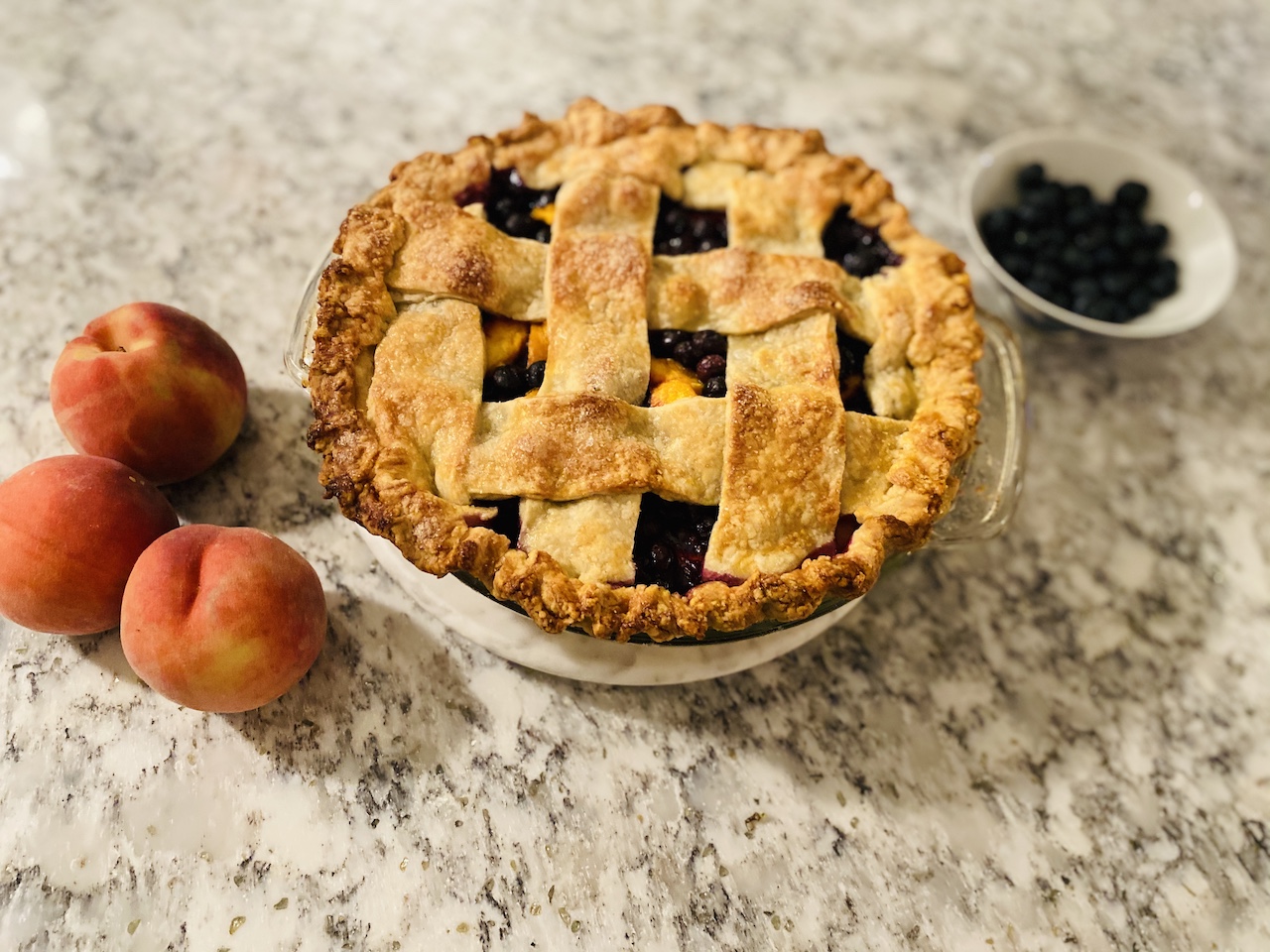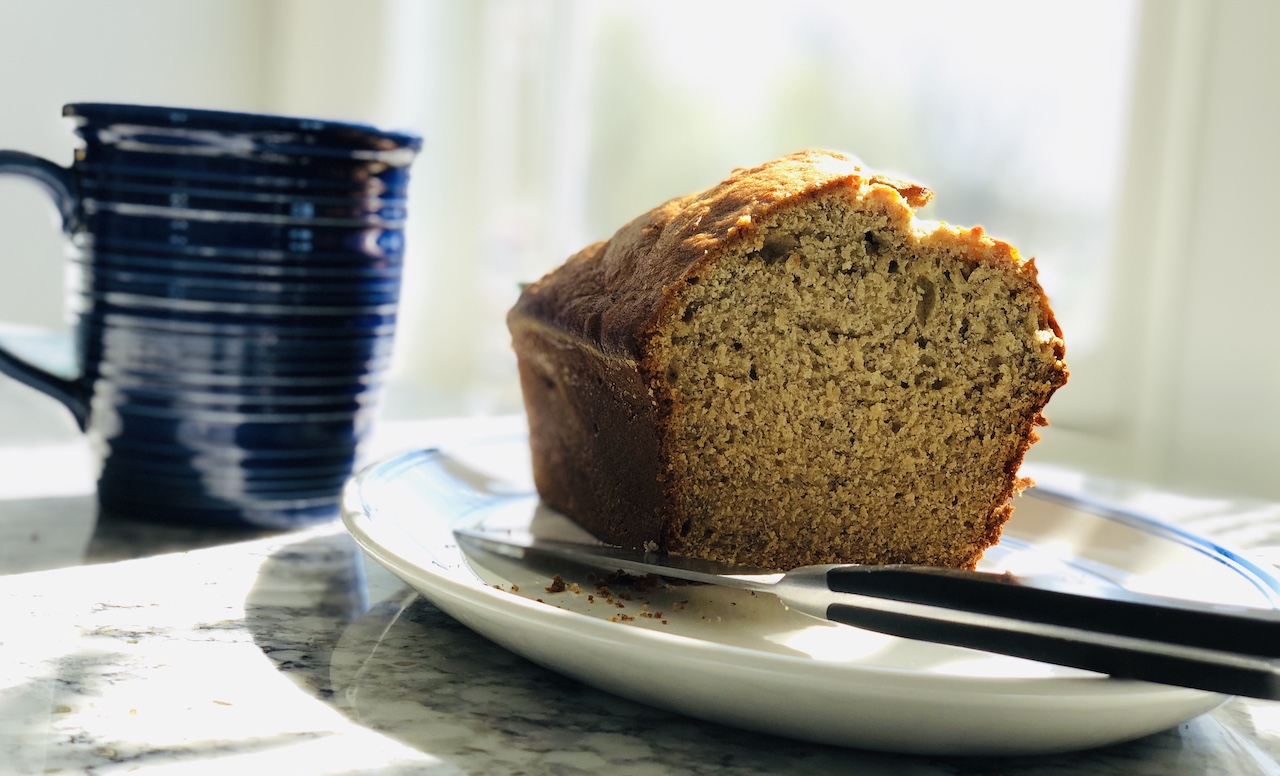
Blueberry-Peach Pie
When I was a child, vacation meant pie. Key lime pie, strawberry rhubarb pie, but most importantly, blueberry peach pie. In my memory, this was the perfect pie: not too sweet, just tart enough, with a flaky crust. We would pick it up from a pie stand on the side of the road and I would hold it carefully on my lap on the ride home, feeling the heat from the freshly baked pie through the container. That pie stand disappeared some years ago, but since then I’ve been trying to recreate this perfect pie. I’ve spent years trying out different crusts – all butter, with vodka, butter and shortening – but just one tablespoon of apple cider vinegar here makes all the difference. The filling is sweet but still a little tart, with no cornstarch and no frozen berries: just the best pie dough I can imagine with that perfect mix of blueberries and peaches.
Blueberries are the focus today, since here in the Midwest we are at the height of blueberry season. The US is the world’s largest producer of blueberries, producing an estimated 690 million pounds in 2016. Despite the large domestic production, the US is actually a net importer of blueberries, due to the large imports during the winter months when they don’t grow in the US. In 2017, the US imported 137.8 million pounds of fresh blueberries, over half of which came from Chile.
Blueberries are an exceptionally seasonal crop. While in the US the season runs from April through September, the blueberry season in any single location is fairly short, usually about eight weeks. Blueberry pickers often follow the harvest, from state to state, traveling up the eastern seaboard, from Florida to Georgia to New Jersey and even up to Michigan. On the West Coast, blueberries have recently become big business, with large growers in California, Oregon, and Washington.
Blueberry picking is seen as a “good” agricultural job. Blueberries are generally harvested by hand so that they don’t get injured during picking. (Machines are used to harvest blueberries for processed foods.) Although it’s tedious work, it’s still easier than strawberry picking, which requires stooping all day, and better than apple picking, which requires climbing up and down ladders. But there are numerous examples of child labor, withheld wages, and exploitation on American farms. About ten years ago, investigative journalists found four young children working on a blueberry farm in western Michigan that sold to Walmart and Kroger. More recently, state inspectors in New Jersey cited six blueberry farms for violating New Jersey’s Water Pollution Control Act and cited eight farms for using storage sheds as illegal housing for migrant workers.,
There have also been many instances of exploitation of workers on H-2A visas, visas granted to short-term agricultural workers to work for a specific employer. H-2A visas are used by berry producing companies to fill agricultural jobs when they can’t find enough American workers. In 2018, berry farmers requested the largest number of workers for any type of crop, 11 percent of the total visas. As the Trump administration has cracked down on undocumented workers, there has been an increase in H-2A workers. There is no annual cap on these visas, and the Trump administration has continued to issue them (in contrast to most other visas), making them an increasingly important source of agricultural workers. In 2018, the US government issued over 200,000 H-2A visas, accounting for about 10 percent of full-time crop agricultural workers. This is a significant increase since 2008, when the government issued only 64,000 H2-A visas.
The H-2A program makes workers especially vulnerable, even though they have visas to work in the US. Although the practice is illegal, many workers pay agents to receive visas for work at a specific farm, which means that they arrive in the US indebted to the middleman. Once in the US, workers are tied to their employer since they can only legally work for that single employer. According to a 2013 report by the Southern Poverty Law Center, workers are systematically cheated out of wages, have their passports and documents seized, are “forced to live in squalid conditions,” and are “subjected to human trafficking and debt servitude.” If workers complain, they can be fired, leaving them unable to work anywhere else and in a tenuous legal position.
Because of the prevalence of H-2A workers in berry production, it is not surprising that there have been instances of large-scale exploitation in the berry industry. In 2017, the Department of Labor issued a $3.5 million fine to one of the largest fresh blueberry producers, Munger Bros. LLC (and its affiliated companies, Crowne Cold Storage LLC and Sarbanand Farms LLC) for underpaying workers, providing workers with unsanitary housing, and discriminating against US workers in hiring. The farm came under scrutiny after a worker collapsed and died while working on Sarbanand Farms in Washington in 2017. In a consent judgment, the court ordered the company to pay $2.5 million in back wages to workers and $1 million as a civil penalty. It also prohibited Munger Bros. from participating in the H-2A visa program for three years. In 2018, the Washington state Department of Labor and Industries fined Sarbanand Farms $150,000 for its refusal to grant workers rest and meal breaks.
Problems with the H-2A visa system are not unique to berry production. These types of labor and human rights violations permeate the system. We need better enforcement of labor and employment laws (as well as stronger labor and employment laws to enforce) and a system in which companies are forced to care about their workers. So what about blueberries? This week I bought blueberries and peaches from the local farmer’s market. While I don’t know what the labor conditions on those farms are like, it’s still a better bet than buying from grocery stores that source from industrial farms.
If you want to learn more about working conditions at one of the affiliates of Munger Bros., read this article in Mother Jones. To learn more about the H-2A visa program, check out this article in Civil Eats, as well as this report by the Southern Poverty Law Center.
Blueberry-Peach Pie
Course: Dessert, Recipe8
servings4
hoursThis pie is adapted from two different sources. The dough is adapted from Alison Roman’s recipe for The Only Pie Crust in her cookbook, Dining In. (It is also in her second cookbook, Nothing Fancy.) The filling is adapted from the recipe for Blueberry-Nectarine Pie in Baking with Julia by Dories Greenspan and Julia Child.
If you don’t want to make your own pie crust, feel free to use a store-bought crust and enjoy the delicious mix of blueberries and peaches.
Ingredients
- Pie Crust
2 ½ cups all-purpose flour
2 teaspoons sugar
1 teaspoon kosher salt
1 ¼ cups (2 sticks plus 4 tablespoons) unsalted butter, cut into 1-inch pieces and chilled
1 tablespoon apple cider vinegar
¼ cup ice water, plus more as needed
- Filling
3 cups blueberries
2 cups peaches, peeled and sliced into quarter-inch pieces
½ cup sugar, plus 1-2 tablespoons for sprinkling on top
1 tablespoon lemon zest
2 tablespoons lemon juice
1 tablespoon flour
¼ teaspoon salt
1 large egg
1 tablespoon cold water
Directions
- Pie Dough
- Make the ice water. Add a few ice cubes to cold water and set aside.
- In a large bowl, mix the flour, sugar, and salt together.
- Add the butter and mix into the flour. (I use my hands for this part to break the butter pieces apart and mash them into the flour.) Work quickly so that the butter doesn’t melt. If the butter is getting too soft, put the bowl in the fridge for a few minutes. You are ready for the next step when the pieces are about the size of crumbs and small pebbles.
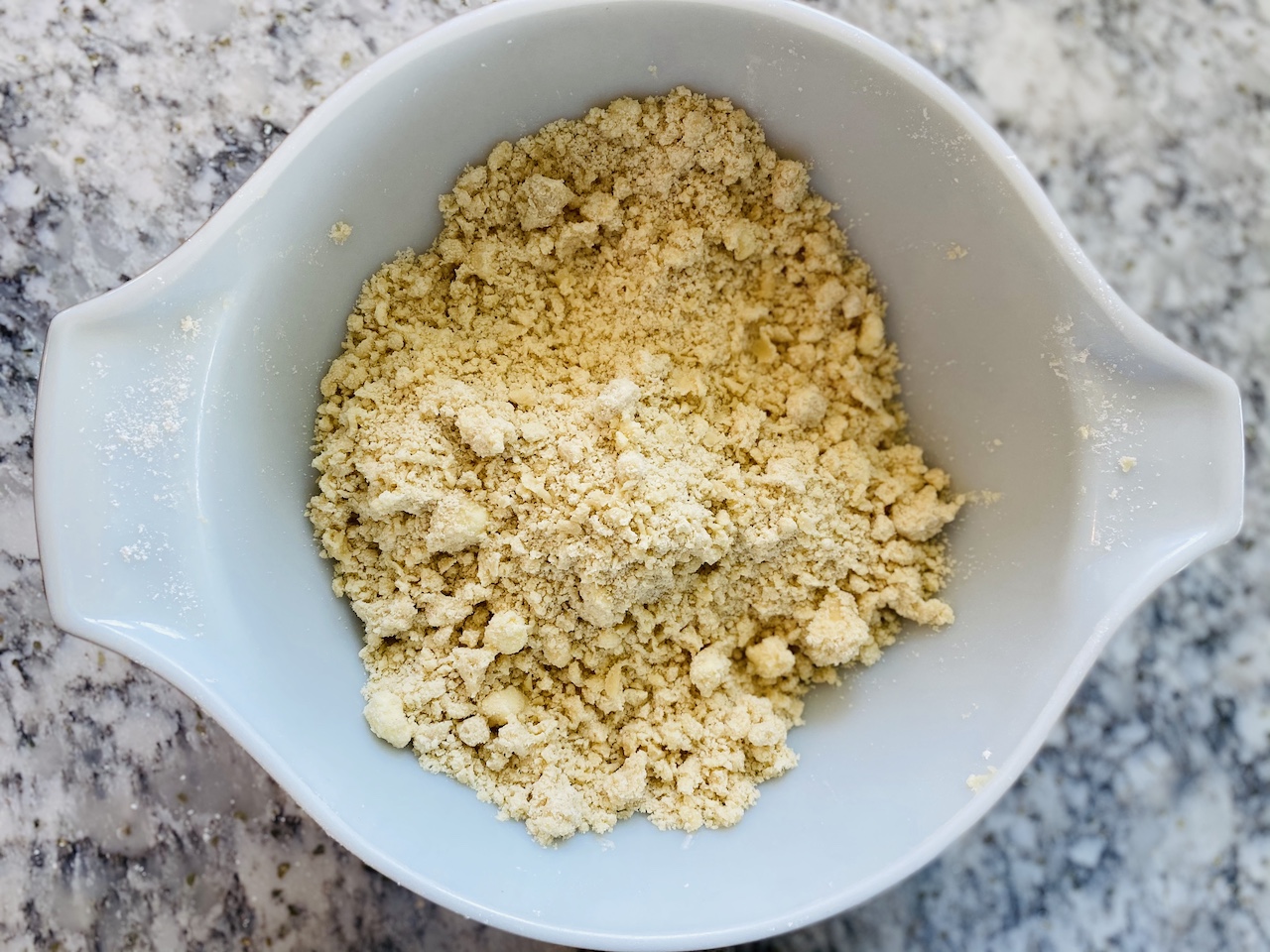
- Combine the apple cider vinegar with ¼ cup of ice water. Set the rest of the ice water aside to be used if needed.
- Drizzle the apple cider vinegar and water over the flour. Using your hands, mix the water and flour together. When it begins to combine, use your hands to knead the dough down into the center of the bowl, trying to incorporate all the dough into the main ball. Add water as needed, but be careful not to overwater the dough. It is ready to be chilled when it has become a slightly crumbly ball, but sticks together as one mass.

- Split the dough into two even portions. Roll into balls and flatten slightly and then wrap tightly in plastic. Store the dough in the fridge for at least two hours and up to 4 days.

- Filling
- To make the filling, mix the blueberries and peach slices together in a large bowl. Add ¼ cup of sugar, the lemon zest, lemon juice, flour, and salt and stir everything together.

- Rolling out the Pie
- Preheat the oven to 375 degrees.
- Take out one portion of the dough. Lightly sprinkle a hard surface with flour, and roll out the dough, rolling from the inside to the outside of the dough, until it’s about one inch larger than the pie pan. Turn the dough one-quarter of a rotation as you roll it out, trying to keep it round. (This dough can be hard to roll out. That’s okay, just be patient and keep working. It can also be a bit crumbly and split apart at the edges. Don’t worry – just fill the gaps with dough from other parts and keep rolling it out.)
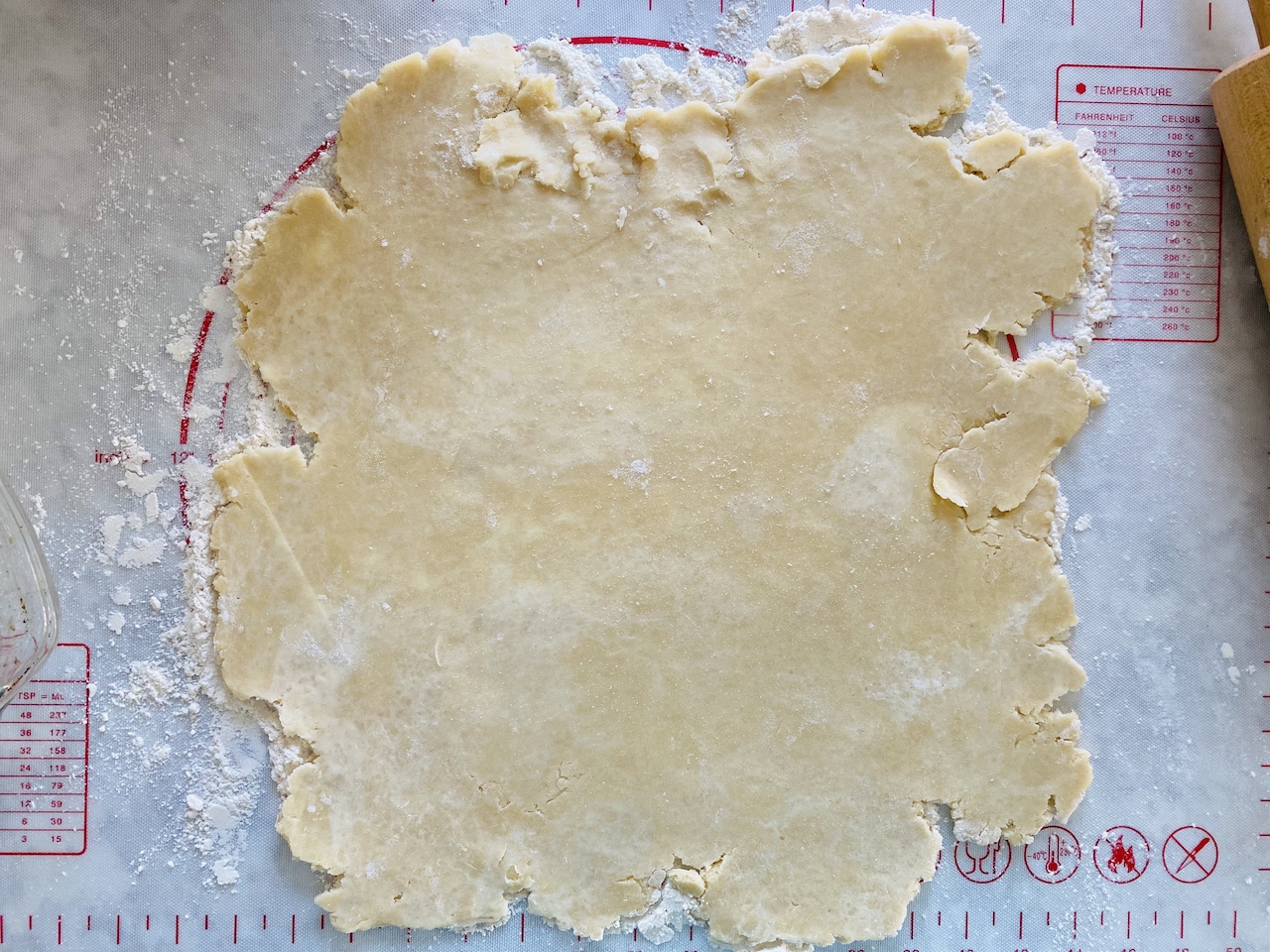
- When the dough is about one inch larger than the pie pan, gently fold the dough over the rolling pin and move it onto the pie pan. Gently pat the dough into the pan and trim it, leaving about 1-inch of dough hanging over the pie plate.
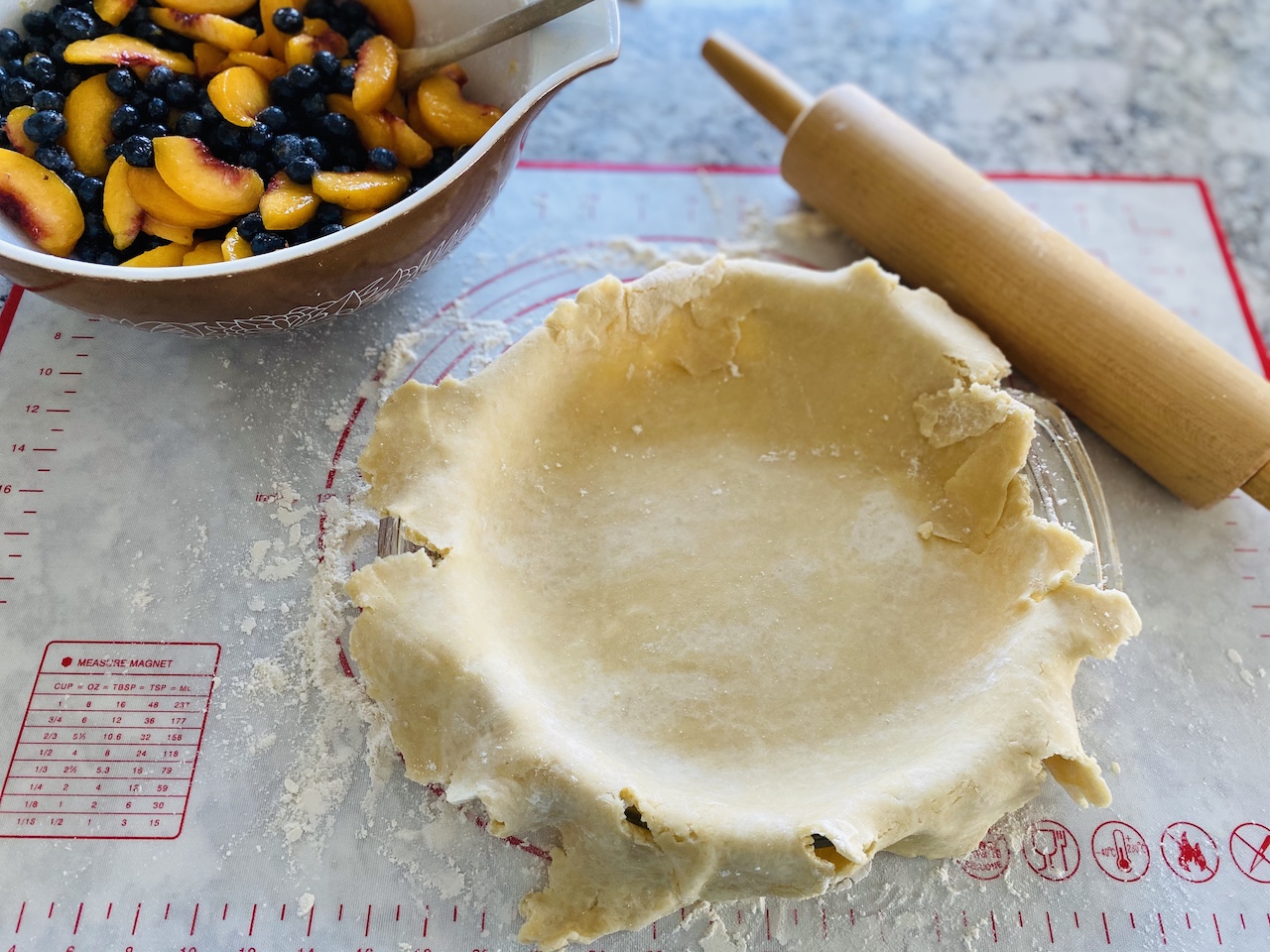
- Put the pie pan with dough back into the fridge while you roll out the second piece of dough. Follow the same steps as above.
- Take the pie pan out of the fridge and spoon all of the filling into it. It should be full, with a nice dome of fruit, but not overflowing.

- You now have two options: you can create a simple crust as a single layer or a lattice top. For a simple crust, follow the same directions as above, using your rolling pin to carry the rolled-out dough onto the pie. Trim the top layer of dough, leaving ½-inch of dough hanging over the pie plate. You will then crimp the dough, as explained below. Then, using a sharp knife, cut four 1 ½-inch slits in the center of the pie, to let out steam. Add the egg wash and sugar as described below.
- To create a lattice top, roll the dough out as above. Then cut the dough into two-inch strips. Lay three strips in a row on top of the pie, evenly spaced. Add one strip in the opposite direction, laying it over the first strip, under the second, and over the third. Repeat with the other pieces of dough. (Switch the order for the second strip, placing it under the first strip, over the second, and under the third. For the third strip switch it again, so that it goes over the first strip, under the second, and over the third. You will have to lift up alternate strips to create this lattice pattern.)
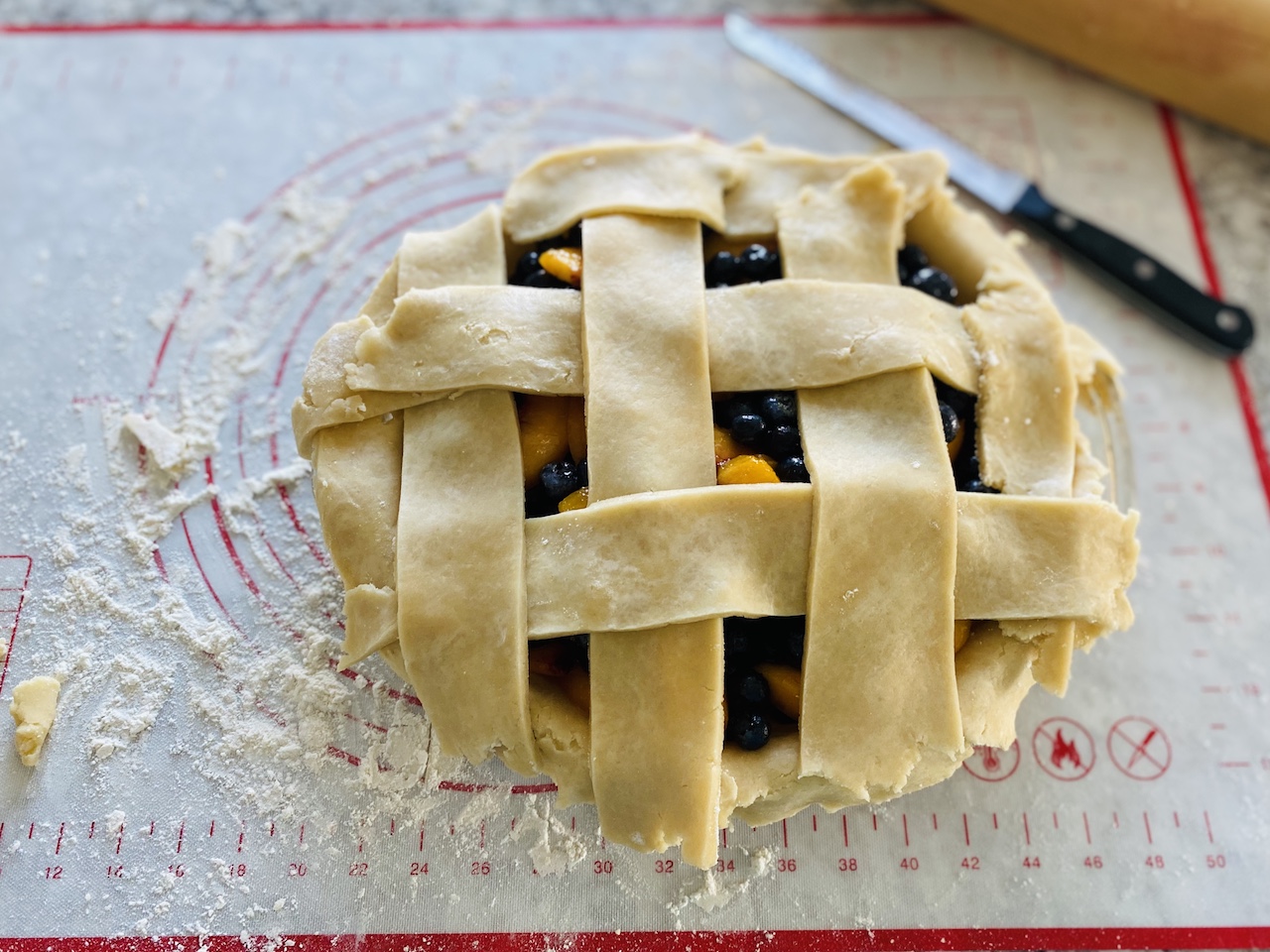
- Crimp the sides. There are many ways to do this, but start by folding the bottom piece of dough upwards over the top and pinch the two pieces of dough together. (If there is too much dough, trim both pieces to closer to ½-inch.) Making sure that the dough is still cold, use the knuckles on your index and middle finger to press from the inside out, while simultaneously pressing inward with the index finger of your other hand. Move around the pie crimping the edges.
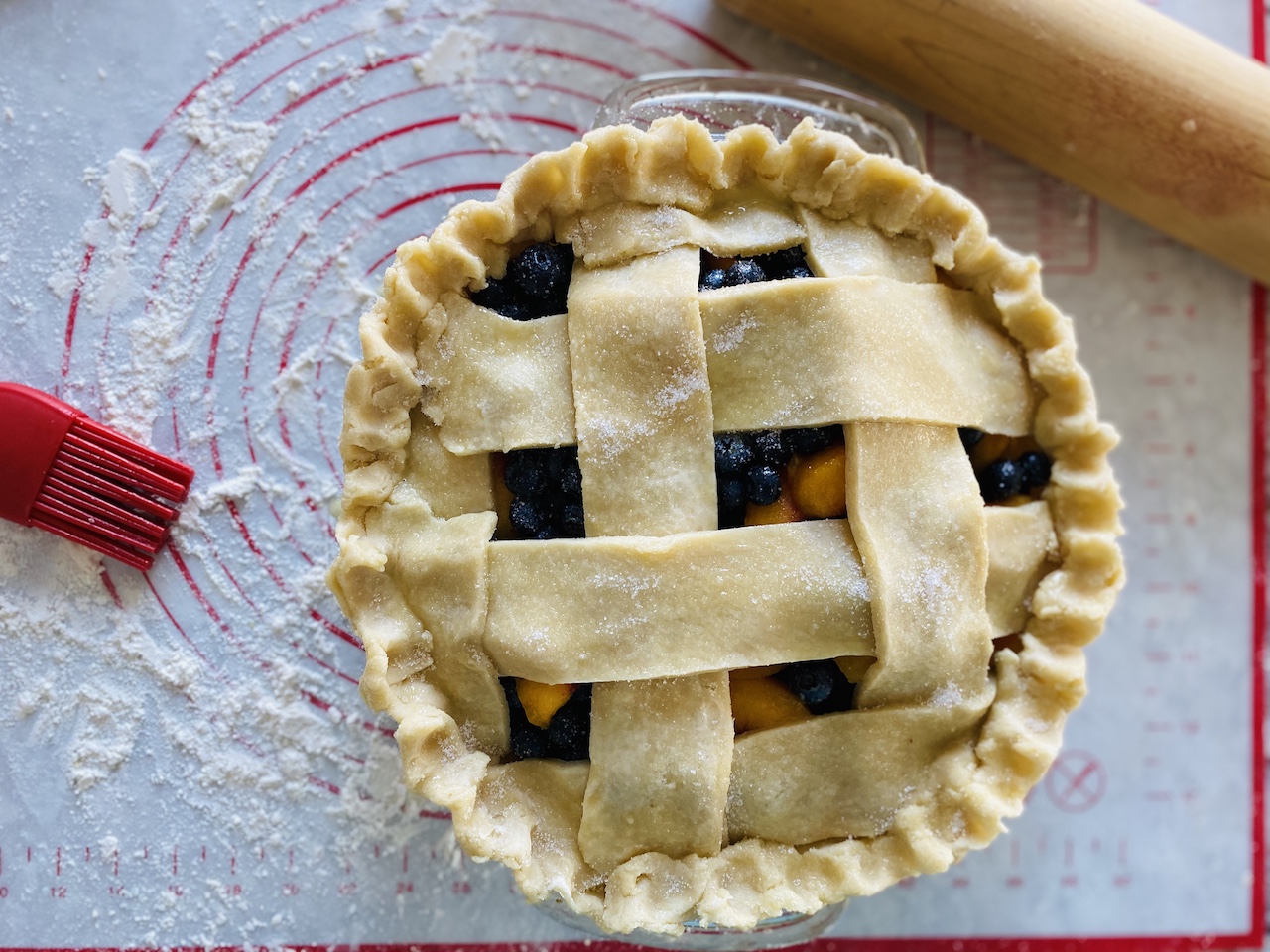
- Put the pie dough back in the fridge while you make the egg wash. Mix one large egg with 1 tablespoon of cold water. Whisk together.
- Brush the top of the pie with the egg wash. Then sprinkle 1-2 tablespoons of sugar on the crust evenly.
- Bake for 45-55 minutes. The pie is done when it is golden brown and bubbling.
- Remove from the oven and let it cool for at least 30 minutes. Eat and enjoy!
